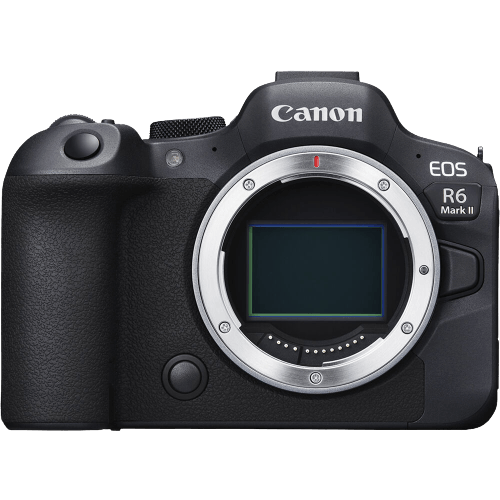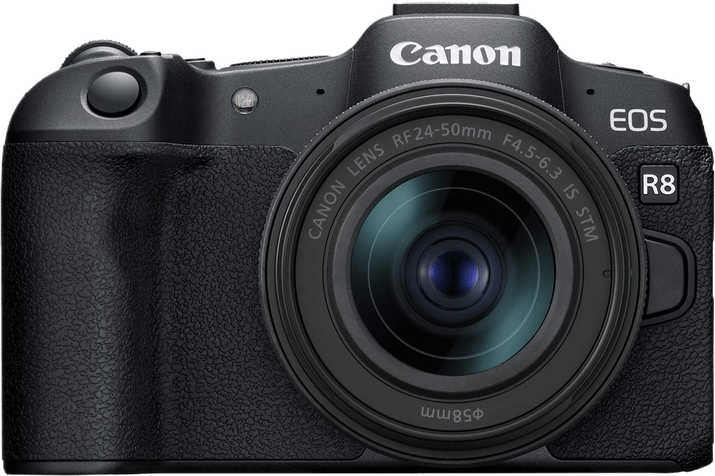Canon EOS R6 Mark II vs EOS R8 Comparison
Canon EOS R6 Mark II

Canon EOS R8

The Canon EOS R6 Mark II takes the lead with a score of 78/100, while the Canon EOS R8 trails slightly behind at 76/100. Both cameras share similarities as mirrorless models with launch prices of $2499 for the R6 Mark II and $1499 for the R8. They were announced in 2022 and 2023, respectively.
In terms of dimensions, the R6 Mark II measures 138.4 × 98.4 × 88.4mm and weighs 588g, making it slightly larger and heavier than the R8, which measures 133 x 86 x 70mm and weighs 461g. The R6 Mark II’s higher score reflects its superior performance and features, justifying the higher price tag.
On the other hand, the R8’s lighter weight and more compact size make it more portable and easier to handle. Additionally, its lower price point may appeal to budget-conscious consumers, despite the slightly lower score.
Taking these factors into account, the Canon EOS R6 Mark II emerges as the better option for those seeking top performance and features, while the Canon EOS R8 may be more suitable for those prioritizing portability and affordability.
Canon EOS R6 Mark II vs EOS R8 Overview and Optics
The Canon EOS R6 Mark II emerges as the winner in our comparison, scoring 83/100 in optics, while the Canon EOS R8 receives a score of 77/100. Both cameras share several specifications, including 24 megapixels, 40 shooting speed, CMOS sensor type, Digic X processor, full-frame sensor size, and Canon RF lens mount. However, the R6 Mark II outperforms the R8 in certain aspects, giving it the edge in our evaluation.
One significant advantage the R6 Mark II holds over the R8 is its image stabilization feature. This allows the R6 Mark II to capture sharper images in various shooting conditions, especially in low light or when using longer focal lengths. This feature is absent in the R8, making it less versatile when it comes to handling camera shake.
On the other hand, the R8 has a higher DXOMARK score for its sensor, at 94, compared to the R6 Mark II’s score of 91. This indicates that the R8’s sensor provides slightly better image quality and dynamic range. However, the lack of image stabilization in the R8 could negate this advantage in certain situations.
Taking all factors into consideration, the Canon EOS R6 Mark II offers superior performance in terms of optics, primarily due to its image stabilization feature. While the R8 does have a marginally better sensor, the absence of image stabilization makes it less versatile and reliable in various shooting scenarios. Therefore, the R6 Mark II is the better choice for photographers seeking a well-rounded camera with excellent optical performance.
Canon EOS R6 Mark II vs EOS R8 Video Performance
The Canon EOS R8 outperforms the Canon EOS R6 Mark II in video capabilities with a video score of 91/100 compared to the R6 Mark II’s 83/100. Both cameras share some common video specifications, such as a maximum video resolution of 4K and maximum video dimensions of 3840 x 2160. Additionally, both cameras have built-in time-lapse functionality, allowing for creative video shooting.
The Canon EOS R8 surpasses the R6 Mark II with its significantly higher maximum video frame rate of 180fps, compared to the R6 Mark II’s 60fps. This higher frame rate allows the R8 to capture smoother slow-motion footage, providing more flexibility and creative options for videographers.
The Canon EOS R6 Mark II, although it has a lower video score, still offers quality video capabilities. Its 60fps frame rate is suitable for most standard video projects and is sufficient for many users. However, it does not provide the same level of versatility and creative options as the R8’s higher frame rate.
Considering the differences in video capabilities, the Canon EOS R8 is the superior choice for videographers seeking advanced and versatile video features, such as the 180fps frame rate for slow-motion footage. In contrast, the Canon EOS R6 Mark II remains a solid option for those who require quality video performance but do not need the additional creative options provided by the R8.
Canon EOS R6 Mark II vs EOS R8 Features and Benefits
The Canon EOS R8 emerges as the winner with a feature score of 85/100, while the Canon EOS R6 Mark II scores 72/100. Both cameras share several specifications, making them quite similar in some aspects. They both have a 3-inch screen size, 1,620,000-dot screen resolution, touchscreen capabilities, flip screens, Wi-Fi, and Bluetooth.
The Canon EOS R8 surpasses the R6 Mark II in terms of features, which contributes to its higher score. However, it is essential to note that the R8 does not have GPS functionality, unlike the R6 Mark II. Despite this, the R8 still manages to outperform the R6 Mark II, indicating that it excels in other areas not mentioned in the provided specifications.
On the other hand, the Canon EOS R6 Mark II has a slightly lower feature score but offers GPS functionality, which the R8 lacks. This feature could be beneficial for photographers who require location-based information for their work. Despite being the losing camera in this comparison, the R6 Mark II’s GPS functionality gives it an edge in a specific niche.
Taking these points into account, the Canon EOS R8 is the superior camera in terms of overall features, as evidenced by its higher score. However, the Canon EOS R6 Mark II may be more suitable for photographers who need GPS capabilities. It is crucial to consider the specific needs and preferences of the user when choosing between these two cameras.
Canon EOS R6 Mark II vs EOS R8 Storage and Battery
The Canon EOS R6 Mark II outperforms the Canon EOS R8 in storage and battery, with a score of 68/100 compared to the R8’s 35/100. Both cameras accept SD, SDHC, and SDXC memory cards and offer USB charging. However, the R6 Mark II has two memory card slots, while the R8 only has one. Additionally, the R6 Mark II is compatible with faster UHS-II memory cards, giving it an edge in storage capabilities.
In terms of battery life, the R8 has a slight advantage, providing 370 shots per charge, while the R6 Mark II offers 360 shots. The R8 uses the LP-E17 battery type, whereas the R6 Mark II uses the LP-E6NH. Although the R8 has a slightly longer battery life, the R6 Mark II’s superior storage options and compatibility with faster memory cards make it the better choice for photographers who prioritize storage and battery performance.
Canon EOS R6 Mark II vs EOS R8 Alternatives
Are you considering buying or upgrading from a Canon R8 or R6 Mark II? Our camera comparison tool can help you weigh up its price and performance against the competition.
Here are some related popular camera comparisons to check for inspiration:
